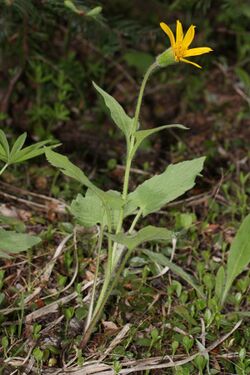Biology:Arnica cordifolia
| Arnica cordifolia | |
|---|---|

| |
| Wenatchee Mountains, Washington (state) | |
| Scientific classification | |
| Kingdom: | Plantae |
| Clade: | Tracheophytes |
| Clade: | Angiosperms |
| Clade: | Eudicots |
| Clade: | Asterids |
| Order: | Asterales |
| Family: | Asteraceae |
| Genus: | Arnica |
| Species: | A. cordifolia
|
| Binomial name | |
| Arnica cordifolia Hook.
| |
| Synonyms | |
|
Synonymy
| |
Arnica cordifolia is a species of arnica in the sunflower family, known by the common name heartleaf arnica.[2] It is native to western North America.
Description
This is a rhizomatous perennial herb producing one or more erect stems reaching a maximum height of about 60 centimetres (2 feet).[3] It has two to four pairs of leaves on the stem, each on a long petiole. The leaves are heart-shaped to arrowhead-shaped and finely toothed along the edges. The inflorescence bears one or more daisylike flower heads 5–9 cm (2–3 1⁄2 inches) in width,[3] lined with white-haired phyllaries and sometimes studded with resin glands. The center of each head contains golden yellow disc florets and a fringe of 10–15 bright golden ray florets approaching 3 cm (1 1⁄4 in) in maximum length.[3][4][5][6][7] The flowers usually bloom from April to June, but sometimes do so as late as September.[3]
The fruit is a hairy achene up to 1 cm (1⁄2 in) long, not counting its off-white pappus. Seeds are dispersed on the wind. An individual plant can live 12 years, surviving periodic wildfire by resprouting from its long, slender rhizome afterward.[7][8]
The species could be confused with the similar Arnica latifolia, from which it can be distinguished by the leaves. The leaves of A. cordifolia are larger and heart-shaped.[9]
Distribution and habitat
It is native to western North America from Alaska to California to New Mexico, as far east as Ontario and Michigan.[10][11] It is a plant of many habitat types, including coniferous forests, and moist mountain meadows from sea level to altitudes of above 3,700 metres (12,000 ft), but most commonly between 1,200–3,400 m (4,000–11,000 ft).[10][7]
Uses
The dried leaves can be made into a poultice or tincture to treat strains and bruises.[12]
References
- ↑ The International Plant Names Index
- ↑ Calflora taxon report, University of California, Arnica cordifolia Hook. heart leaved arnica, heartleaf arnica
- ↑ 3.0 3.1 3.2 3.3 Spellenberg, Richard (2001). National Audubon Society Field Guide to North American Wildflowers: Western Region (rev ed.). Knopf. pp. 355. ISBN 978-0-375-40233-3. https://archive.org/details/nationalaudubons00spel/page/355/.
- ↑ Klinkenberg, Brian, ed (2017). "Arnica cordifolia". Lab for Advanced Spatial Analysis, Department of Geography, University of British Columbia, Vancouver. http://linnet.geog.ubc.ca/Atlas/Atlas.aspx?sciname=Arnica%20cordifolia. Retrieved 2019-09-15.
- ↑ Giblin, David, ed (2018). "Arnica cordifolia". Burke Museum, University of Washington. http://biology.burke.washington.edu/herbarium/imagecollection/taxon.php?Taxon=Arnica%20cordifolia. Retrieved 2019-09-15.
- ↑ "Arnica cordifolia". Jepson Herbarium; University of California, Berkeley. 2018. http://ucjeps.berkeley.edu/cgi-bin/get_IJM.pl?tid=Arnica%20cordifolia. Retrieved 2019-09-15.
- ↑ 7.0 7.1 7.2 Flora of North America Vol. 21 Page 374 Heartleaf arnica, Arnica cordifolia Hooker, Fl. Bor.-Amer. 1: 331. 1834.
- ↑ Ecology Fire Ecology
- ↑ Reiner, Ralph E. (1969). Introducing the Flowering Beauty of Glacier National Park and the Majestic High Rockies. Glacier Park, Inc.. pp. 44.
- ↑ 10.0 10.1 Sullivan, Steven. K. (2018). "Arnica cordifolia". http://www.wildflowersearch.com/search?&PlantName=Arnica+cordifolia. Retrieved 2019-09-15.
- ↑ Biota of North America Program 2014 state-level distribution map
- ↑ Fagan, Damian (2019). Wildflowers of Oregon: A Field Guide to Over 400 Wildflowers, Trees, and Shrubs of the Coast, Cascades, and High Desert. Guilford, CT: FalconGuides. pp. 101. ISBN 1-4930-3633-5. OCLC 1073035766. https://www.worldcat.org/oclc/1073035766.
External links
Wikidata ☰ Q2863306 entry
 |

